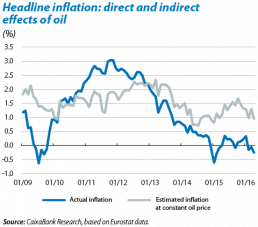Imagine, dear reader, a small country in population terms but advanced in economic terms. In other words, with a high per capita income. A sovereign state that is very much a part of the global economy but which has managed to maintain a high degree of independence both in its monetary and budgetary policy in spite of belonging to the European Union.
Consider, dear reader, the key macroeconomic figures for this country for the current year, according to the European Commission: expected GDP growth of 2%, a 7.9% unemployment rate, a 5.7% current account surplus, a budget balance of –2.4% and public debt totalling 40.3% of GDP. A country, moreover, that throughout the global financial crisis has admirably managed to weather the storm, posting cumulative GDP growth of 6.1% between 2007 and 2013.
Given all these figures you would agree with me, dear reader, that the economic situation of the country in question is, at the very least, enviable when compared with that of many developed countries. However, there is a reason why economics is called the «dismal science» and not all can be good news. It appears that this country, which is actually Sweden, is also suffering from a disease affecting many advanced economies: the risk of deflation.
In spite of more than reasonable growth, in spite of the fact that, even with the crisis, its excess capacity is not particularly substantial and that interest rates are already rock-bottom, inflation expectations have gradually fallen and the inflation figure itself has been negative on several occasions during 2014. So what is happening? Where does this unusual deflationary pressure come from?
One key factor is one of Sweden's economy most outstanding traits over the last few years: the tendency for its currency, the krona, to appreciate as a consequence of its economic growth, its high degree of competitiveness and its stability-driven monetary and fiscal policy.
It is precisely this appreciation of the currency that has led Sweden to import deflation, at a time when many of its trading partners (particularly the United States, United Kingdom, Japan and, to a lesser extent, the euro area) were embarking on unconventional monetary policies. The currency's continued appreciation directly reduces the price of imported goods and services, pushing down the general consumer price index.
In conclusion, dear reader, in the highly interconnected world we live in today, and whether it wants to or not, a small open economy like Sweden's also feels the effects of the economic policies implemented by the large blocks, especially when these are very aggressive policies. In fact, to a certain extent something similar could be argued for the euro area. It is true that, as a whole, the euro area has a less open economy than Sweden and that its point in the business cycle, as well as its excess capacity, are different. But it is also true that its monetary policy has been much less daring than that of the United States, the United Kingdom or Japan. A portion of the risk of Europe's deflation has therefore been imported. And, for this reason, the European Central Bank may be forced, very much against its will, to implement policies of quantitative easing such as those carried out by the main central banks of the advanced economies.
Jordi Gual
Chief Economist
31 October 2014


